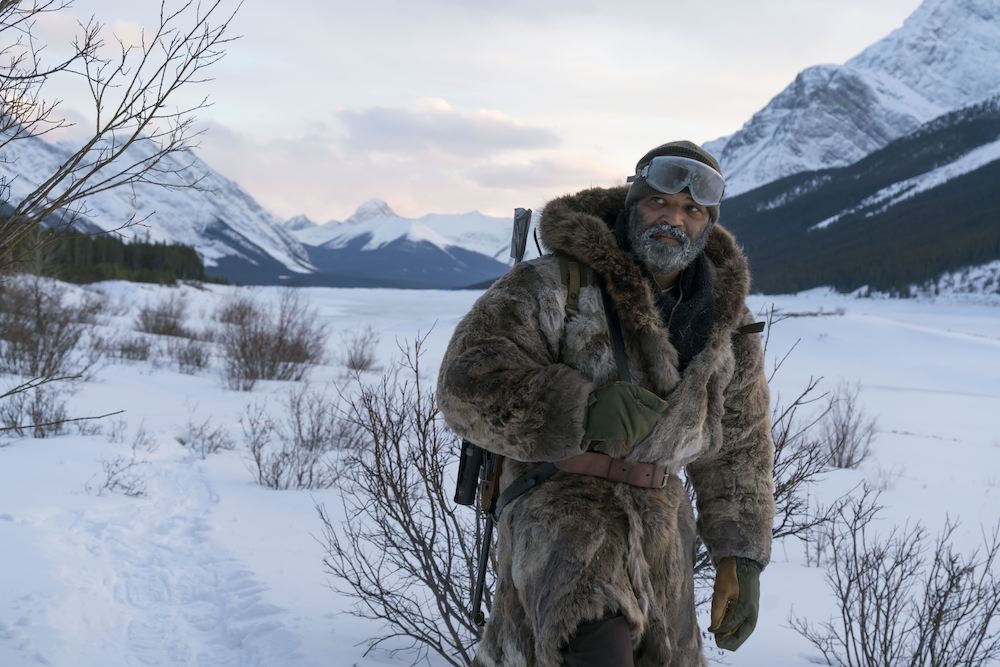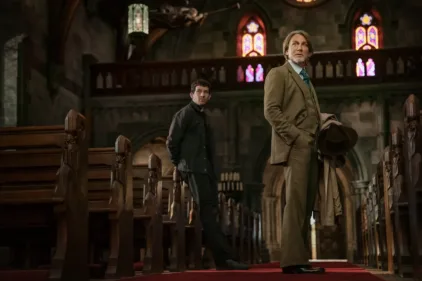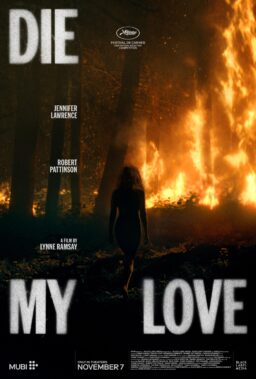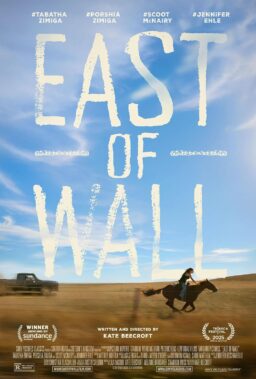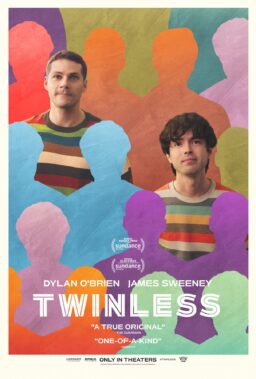In Jeremy Saulnier’s latest film “Hold the Dark,” Jeffrey Wright plays the soft-spoken, highly skilled wolf expert Russell Core, who’s tasked with tracking down a pack of wolves who have taken the six-year-old son of Medora and Vernon Sloane (Riley Keough and Alexander Skarsgård). He tries to make sense of an unforgiving landscape haunted by unknown forces, all the while searching for some salvation for himself. He’s a good man thrust into an environment where goodness has no purchase.
“Hold the Dark” is the latest entry in Wright’s eclectic career on stage and screen. He’s still best known for his Tony and Emmy-winning performance as Belize in the 1993 Broadway production and 2003 miniseries versions of “Angels in America.” He also garnered critical acclaim for his starring role as Jean-Michel Basquiat in Julian Schnabel’s 1996 film “Basquiat.” His film roles range from work in mainstream franchises, like Felix Leiter in the Bond series and Beetee in “The Hunger Games,” to more independent fare like his turns in Jim Jarmusch films “Broken Flowers” and “Only Lovers Left Alive.” In short, there’s no pinning the man down.
RogerEbert.com sat down with Wright to discuss “Hold the Dark,” shooting in cold weather, wolves, and the new “Angels in America.”
I personally love reactive lead performances. I think they’re really interesting and they ask different things of the audience and inevitably require different skills from the actor. I’m curious how you approach a character like Russell Core in “Hold the Dark” who primarily reacts to the machinations of his environment?
Well, one of the things that I found interesting and satisfying about playing Core was that he stumbles into a type of heroism that he’s completely unprepared to handle, and somehow through his being thrust into this crucible, he manages to find what he’s looking for, which is something closer to himself. Jeremy [Saulnier] would often talk about him being broken, so even though he’s in this epic environment, and though he’s clearly a man who’s skilled with nature, he should never really perceive himself to be heroic. So, Jeremy and I would say, “No, that’s too heroic. More broken.”
That’s really at the heart of what the story is about, too. It’s kind of a mythic journey that an ordinary man finds himself on, as opposed to Odysseus or something. He’s just old, broken Russell Core trying to, perhaps in some ways, discover his end, but finds a new beginning.
You shot the film in Alberta, Canada in the winter. Do you thrive in cold weather?
Oh, I don’t mind cold weather. I ski and grew up skiing. I went to school up in Massachusetts where winter starts late October and ends in early April, so … [Laughs.]
I’m from Chicago. It’s the same thing.
Yeah. I’m used to permafrost. We wanted the elements to be as intense as they could for obvious cinematic reasons, and we got a good deal of that. We were all fully suited up and thermaled out, so it wasn’t an issue. I wanted to see the steam shooting out of my mouth. I wanted to feel the ice crystals forming in my beard. It was all additive to the experience and to the film. Then at the end of the day, most of the time, I would go off and do some hot yoga somewhere to kind of balance it out in that way.
Was this the coldest set you’ve worked on?
No, I was hoping that it would be. The coldest set I’ve ever worked on … well, it was one day on “Ride with the Devil,” Ang Lee’s film that we shot in Missouri and Kansas. There was one day, while we were still in pre-production, because we had about three to four weeks of boot camp prior to filming that where we were riding horses and shooting guns and training, and it was predicted to snow the falling day. Ang said, “Yeah, if it’s gonna snow, then we’re just gonna get a little guerrilla unit out and we’re gonna film a couple scenes so we can capture all of the seasons.” I said, “Cool.” So, I got up that morning at five o’clock and we headed out to the middle of the prairie somewhere—just windswept, bitter prairie—and I looked at the thermometer in the car and it said -17 ° Fahrenheit. I was like, “Oh, wow.” So we stepped out in our little Civil War-era boots and felt hats and froze our asses off. But we got the shots and it was really cool.
Unfortunately, the studio decided once we filmed the movie that the racial dynamics were too weird for them, having a black man who wasn’t waiting for the white savior Northerner to come free him but rather was freeing himself from the clutches of the Confederacy and the constructs of white supremacy. That was a little too complicated for them to handle. So we suffered that bitter cold so that the studio could later toss the movie to the back-burner.

I’m curious if you did any research on wolves as preparation for the role? I don’t know much about wolves, but they seem like a fascinating animal.
Yeah, wolves are fascinating. I’ve always been kind of a canine-inclined guy. I’ve always had dogs. My grandmother always thought there was something of the dog in me because she would wonder why all dogs would take to me. So I did do a bit of research. In fact, I drove west from Banff through that section of the Canadian Rockies for about maybe an hour-and-a-half, two hours, near a place called Revelstoke and there was a wolf sanctuary there. I went out and studied those guys a bit, and got a lot of really sharp insight from the people who ran the sanctuary about the social habits of wolves: the ways in which they use play and physicality to organize their social hierarchy, how they determine what’s a threat and what’s not, how they determine what exists inside their social circle and what’s outside. They’re incredibly attuned animals, incredibly curious, sensitive, highly playful, really powerful, and just gorgeous.
I read a bit, some wonderful documentaries that I managed to check out, but then on came our wolves to the set, and I was really curious to interact with them. The first day I stepped into their space I was wearing what Core wears during his journey in the wilderness, this huge caribou coat and caribou boots. They collectively took one look at me, and whereas I’m thinking they may confuse me for lunch, they thought I was the strangest looking caribou that they could ever possibly imagine. They were really unsettled by the fact that the caribou was speaking this odd language and also wielding a rifle. They wanted to get the hell away from me as quickly as possible. They got so tripped out by me.
But one of the things that I found out is, because they have this close-knit extended family structure that forms their pack, even the lowest among them is mourned when they die. There’s hierarchy within the whole, but every part of the whole is as meaningful as the other. So they will mourn vocally through their howls, so their howls will be plaintive and emotive to reflect that. When it was required that I call one of them, I tried to find what Core’s howl would be, which, going back to his condition, was a broken howl, a howl that suggested a type of mourning.
Did you see the new “Angels in America” on Broadway?
I saw Millennium Approaches [part one of “Angels in America”] with my kids. Unfortunately, I was bouncing in and out of town, between my schedule and my teenage kids’ mad schedules, and we only managed to see Millennium Approaches. I told them we would watch Perestroika [part two of “Angels in America”] on film. They had never seen the film version, but after watching Millennium Approaches in the theater, they objected to watching it on film.
My son literally sprang out of his seat at the end of the play, when the angel dropped, and said, “Oh my God. That was incredible.” That was the first time I had seen the play, because, of course, I have only been on the inside of it. Aside from the unfortunate renewed political resonances of the play, in that it’s an examination of an American politics that lacks empathy, one of hypocrisy and diminishment, as well as a portrait of Roy Cohn, who’s described by one of the characters as the polestar of evil, and who also happens to be the mentor and former attorney for the current failure of a human who occupies the White House right now, it’s now no longer an archival story even though it’s a revival. It was almost an archival piece when we did it on film. We thought we were progressing towards a more perfect relationship between America and U.S. policy towards vulnerable communities, like the LGBTQ community, but we were sadly mistaken, at least temporarily.
Aside from all that, another thing I was most aware of in watching the play, particularly the first half, is how it has affected me in terms of the way I read and assess scripts, and in terms of the way I think about storytelling. At the same time as the play, I was in the midst of working on the edit for a documentary that I’m producing that will air on HBO on November 8th called “We’re Not Done Yet” about PTSD and the military. It’s about a group of veterans and active service members that I worked with around an arts therapy workshop. They were processing their traumas through poetry and one of them wanted to put on a staged reading of a series of collected poems they had written, and somehow I managed to find myself coming down to Walter Reade to work with them and direct them in this piece.
In the midst of editing that piece, I went to see Millennium Approaches, and I said, wow, the craftsmanship that Tony [Kushner] exhibits in terms of the structure, the balance, and the rhythms of the storytelling, it’s just meticulous. I realized that having stayed inside that level of skill from a writer for a year-and-a-half, seven-hour play has really attuned my understanding of structure. I realized that it was informing work that I was doing in ways I hadn’t really considered before. It’s a glorious piece of writing. The second part is more complicated, because after you create this piece of perfect architecture, it’s raised to the ground, and we’re asked to put those pieces back together in some new fashion. That’s a much more complicated exercise. Much in the same way, the first season of “Westworld” is simpler than the second season of “Westworld” in that you’re reassembling shards of glass. To use a word that’s overused relative to works outside of that play, it’s an absolute masterpiece.

